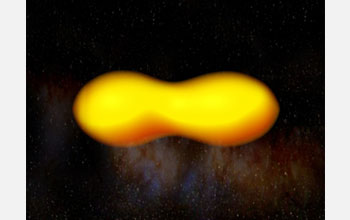News Release 08-049
New Star Systems First of Their Kind
Two binary star systems could explode as yellow supergiants

A nearly identical pair of stars is one of two known yellow binary systems.
April 1, 2008
This material is available primarily for archival purposes. Telephone numbers or other contact information may be out of date; please see current contact information at media contacts.
Researchers funded by the National Science Foundation (NSF) announced today in Astrophysical Journal Letters that they have discovered a faraway binary star system that could be the progenitor of a rare type of supernova.
The two yellow stars, which orbit each other and even share a large amount of stellar material, resemble a peanut. The Ohio State University astronomers and their colleagues believe the two stars in the system, 13 million light years away and tucked inside a small galaxy known as Holmberg IX, appear to be nearly identical, each 15 to 20 times the mass of our Sun.
This work was funded through an NSF continuing grant to support a systematic study of the most massive stars in the local universe. The study is expected to yield masses and radii for dozens of massive stars discovered in a variety of environments. The data produced can be used to test models of massive star atmospheres, winds, and how they evolve both as single stars and in binaries.
"To have discovered a pair of massive interacting stars in this configuration is truly exceptional--sort of like rare squared," said NSF Program Manager Michael Briley. "There is a lot these stars can tell us about how they work and how they influence their environment. But the really exciting part is they may also hold the key to finally understanding why some massive yellow stars explode."
Lead author Jose Prieto, an Ohio State graduate student who analyzed the new system as part of his doctoral dissertation, searched the historical record to see whether his group had found the first such binary. In a surprising twist, his search uncovered another similar system less than 230,000 light years away in the Small Magellanic Cloud, a small galaxy that orbits the Milky Way. The second binary star system was discovered in the 1980s but misidentified at the time. Prieto reassessed the data and realized the system was another yellow super-giant eclipsing binary. Prieto and his colleague suspect the yellow binary systems could be the progenitors of rare supernova linked to yellow supergiants.
Most stars end their life in a supernova at the cooler red end of the temperature scale and a few end in the hotter blue end, Pietro said. Astronomers didn't believe stars would end during the short transitional phase in between--until now.
"When two stars orbit each other very closely, they share material, and the evolution of one affects the other," Prieto said. "It's possible two supergiants in such a system would evolve more slowly and spend more time in the yellow phase--long enough that one of them could explode as a yellow supergiant."
-NSF-
Media Contacts
Diane Banegas, National Science Foundation, (703) 292-4489, email: dbanegas@nsf.gov
Pam Frost Gorder, Ohio State University, (614) 292-9475, email: Gorder.1@osu.edu
Program Contacts
Michael Briley, National Science Foundation, (703) 292-4901, email: mbriley@nsf.gov
Principal Investigators
Jose Prieto, Ohio State University, (614) 292-7881, email: prieto.12@osu.edu
Related Websites
Ohio State University news release: http://researchnews.osu.edu/archive/superyellow.htm
Technical paper: http://arxiv.org/abs/0709.2376
The U.S. National Science Foundation propels the nation forward by advancing fundamental research in all fields of science and engineering. NSF supports research and people by providing facilities, instruments and funding to support their ingenuity and sustain the U.S. as a global leader in research and innovation. With a fiscal year 2023 budget of $9.5 billion, NSF funds reach all 50 states through grants to nearly 2,000 colleges, universities and institutions. Each year, NSF receives more than 40,000 competitive proposals and makes about 11,000 new awards. Those awards include support for cooperative research with industry, Arctic and Antarctic research and operations, and U.S. participation in international scientific efforts.
Connect with us online
NSF website: nsf.gov
NSF News: nsf.gov/news
For News Media: nsf.gov/news/newsroom
Statistics: nsf.gov/statistics/
Awards database: nsf.gov/awardsearch/
Follow us on social
Twitter: twitter.com/NSF
Facebook: facebook.com/US.NSF
Instagram: instagram.com/nsfgov


